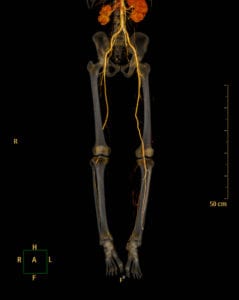
Imaging techniques are some of the most technically sophisticated developments in modern medicine. These imaging devices use ultrasound or electromagnetic radiation to peer into the human body, aiding doctors in diagnosis and treatment. However, it can be hard to visualize some tissues and organs, so doctors may administer contrast agents to highlight important areas. Learn more about contrast agents below to appreciate their role in diagnostic imaging.
The Importance of Contrast in Medical Imaging
Most tissues of the body are opaque, so doctors can’t use light to see the body’s interior. A possible option is to make incisions to visualize the target organ, but the risks and complications of invasive surgery make this option undesirable.
Instead, imaging techniques use other approaches to obtain visual information on the body. CT scans, X-rays, and MRIs are some popular examples. Other methods, such as ultrasound scans, employ sound waves to visualize internal structures.
In all cases, different types of tissue absorb or reflect the waves produced by the imaging device. The machine uses this information to construct an image of the body. However, it can be hard to distinguish between some tissues. To create clearer images, a contrast agent is used to increase the contrast between the target organ and the surrounding tissue. Radiologists can then make more accurate interpretations of the images, which often leads to an accurate diagnosis and better care.
Contrast Agents and How They Work
Different contrast agents have different ways of elucidating the target tissue. Hence, the contrast agent needs to match the specific imaging technique being used.
Iodine- and Barium-Based Contrast Agents
CT scans use a type of electromagnetic radiation that penetrates soft tissues. The amount absorbed by a particular tissue determines the brightness of the corresponding spot on the image. However, CT scans alone are not always enough to investigate many organs because nearby tissues tend to absorb similar amounts of radiation.
To remedy this, patients often take contrast agents containing iodine or barium. Doctors usually inject iodine-based compounds into blood vessels or other body cavities. Meanwhile, barium-based compounds are often used in formulations that patients take orally or rectally.
These contrast agents help regions of the body show up more clearly in CT scans. For example, barium compounds can be used to get detailed images of the colon, since the contrast agent coats the internal surfaces and allows their outline to show up clearly on the scan.
Gadolinium-Based Contrast Agents
MRI scans use changing magnetic fields to view the body. The strong magnetic fields excite the atoms of a particular region. This resonance releases radiofrequency waves that hit the receiver of the MRI machine. The information from these waves determines the resulting image.
Gadolinium is a metallic element that interacts energetically with magnetic fields. Hence, gadolinium compounds help produce a more robust response from the target organ, making it show up clearer on a scan. Unlike iodine and barium, gadolinium amplifies radiofrequency waves instead of blocking them.
Microbubble Contrast Agents
Ultrasound imaging uses high-frequency sound waves as the imaging medium. These vibrations are too fast for patients to feel, and they can penetrate several inches into the body without causing harm. Some of these sound waves bounce off surfaces and boundaries, and the machine uses the characteristics of the reflected waves to construct an image.
Microbubble contrast agents consist of microscopic bubbles suspended in a solution by a stabilizing shell. The high surface area of the bubbles allows more ultrasound waves to reflect, increasing the visibility of tissues containing the agent. After a few minutes, the bubbles harmlessly dissipate.
Medical Imaging Contrast in Bronx, New York
Contrast agents allow for higher quality images of the human body, improving the quality of diagnostic services medical professionals can provide. For the best results, visit a healthcare provider with experience using various imaging techniques.
Located in Bronx, New York, Starling Diagnostics offers a wide variety of diagnostic services to patients. Our specialists combine advanced techniques with compassionate care toward the people we serve. For inquiries, call us at (718) 319-1610 or use this online form to request an appointment.
